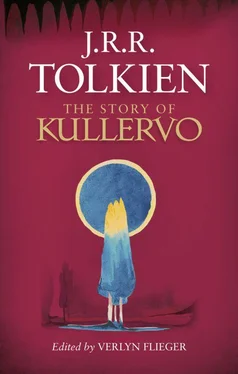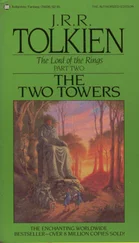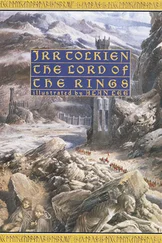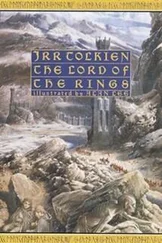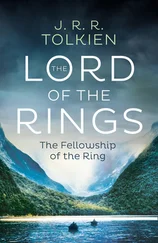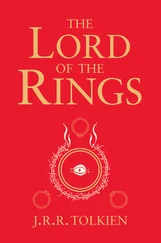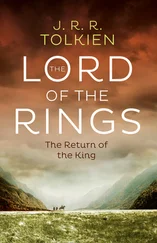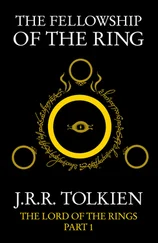But what was it about this particular story that so powerfully called to him that he wrote it not once but several times? Perhaps thinking of its explicitly pagan orientation ‘when magic was yet new’, John Garth calls it ‘a strange story to have captured the imagination of a fervent Catholic’ ( Tolkien and the Great War , p. 26). Tolkien clearly did not find it strange (‘great’ and ‘tragic’ were his adjectives), and seems to have felt no conflict with his Catholicism, which at that point was apparently not very ‘fervent’ anyway. Carpenter cites Tolkien’s acknowledgment that his first terms at Oxford ‘had passed “with practically none or very little practice of religion”’ ( Biography , p. 58), and notes his ‘lapses of the previous year [1912]’ (ibid., p. 66). Connecting Tolkien’s attraction to the Kullervo story to his guardian-enforced separation from Edith, Garth proposes that its appeal may have lain ‘partly in the brew of maverick heroism, young romance, and despair’ ( Tolkien and the Great War , p. 26). Without discounting Garth’s connection of the story to Tolkien’s immediate situation, it seems possible that the story of Kullervo also resonated deeply with the circumstances of his very early life. Kullervo’s description of himself as ‘fatherless beneath the heavens’ and ‘from the first without a mother’ (Kirby vol. 2, p. 101, ll. 59–60) cannot be overlooked, still less two cancelled lines of verse, stark and explicit, transferred unchanged from the Kirby Kalevala wherein Kullervo bewails his fate to one of the ‘chunks of poetry’ in Tolkien’s own story:
I was small and lost my motherfather
I was young (weak) and lost my mother.
(Tolkien MS B 64/6, fol. 11 verso)
The fact that he first included and then crossed out these lines is significant. They may have been at once right on the mark and too close for comfort to the tragedy of his own life. Like Kullervo, Tolkien had lost first his father, and then his mother. When he was small (a child of four) his father died; when he was young (a boy of twelve but surely feeling ‘weak’ at the loss) his mother died suddenly and unexpectedly, from untreated diabetes.
Let us look at the narrative that Tolkien called ‘most tragic’. Strife between brothers leads to the killing of Kullervo’s father Kalervo by his uncle Untamo, who lays waste to his family home and abducts Kullervo’s unnamed mother, identified in the poem only as ‘one girl, and she was pregnant’ (Kirby vol. 2, p. 70, l. 71). Kullervo is born into captivity, and as an infant swears revenge on Untamo, who, after three attempts to kill the precocious boy plus the failure to get any work out of him, sells him as a bondslave to the smith Ilmarinen. The smith’s wife sets him to herding the cattle, but cruelly and deliberately bakes a stone into his bread. When he cuts into the bread, his knife, his only memento of his father, strikes the stone and the point breaks. Kullervo’s revenge is to enchant bears and wolves into the shape of cows and drive them into the barnyard at milking-time. When the smith’s wife tries to milk these bogus cattle they attack and kill her. Kullervo then flees, but being told by the Blue-robed Lady of the Forest that his family is alive, decides to go home, vowing again to kill Untamo. He is deflected from his vengeance by a chance encounter with a girl whom he either seduces or rapes (the story is equivocal on this point). Upon disclosing their parentage to each other, the two discover that they are brother and sister. In despair, the girl throws herself over a waterfall. Consumed with guilt, Kullervo fulfils his vengeance, returning to Untamo’s homestead to kill him and burn all his farm buildings, then asks his sword if it will kill him. The sword agrees, and Kullervo finds ‘the death he sought for’ (Kirby vol. 2, p. 125, l. 341).
I do not propose a one-to-one equation between Kullervo and Tolkien; nor do I claim autobiographical intent on Tolkien’s part. Parallels there certainly are, but Father Francis Morgan, Tolkien’s guardian, was no murderous Untamo (though he did separate John Ronald from the girl he loved). Beatrice Suffield, the aunt in whose care Tolkien and his brother were temporarily put after their mother died, was not the malicious and sadistic smith’s wife — though Carpenter notes that she was ‘deficient in affection’ ( Biography , p. 33). Tolkien was neither a cowherd nor a magician, though he did become a writer of fantasy. Nor did he engage in revenge-killing or commit incest. And though unlike Kullervo he was not mistreated and abused, like Kullervo he was not in control of his own life. There was undeniably something in Kullervo’s story which touched him deeply and made him want to ‘reorganize [it] into a form of [his] own.’ And that something stayed viable as his legendarium took shape.
Garth is right about one thing, however. It is a ‘strange story’, as even a cursory synopsis shows: a perplexing jumble of loosely connected episodes in which people do inexplicable things for unexplained reasons or for the wrong reason or for no reason at all. With the exception of Kullervo, the characters are one-dimensional — the wicked uncle, the cruel foster-mother, the wronged girl; and Kullervo himself, while more fleshed-out, is an enigma both to himself and to those he meets. The story is not so strange, however, in Tolkien’s version, which carefully connects cause, effect, motivation, and outcome. Already a certain modus operandi is in place, the effort to adapt a traditional story to his own liking, to fill in the gaps in an existing story and tidy up the loose ends. The best-known example is The Hobbit , in which Bilbo’s theft of a cup from the dragon’s hoard is a hard-to-miss (for those who’ve read Beowulf ) reworking of a problem passage in that poem where, because the manuscript is damaged, the text is full of holes, with words, phrases and whole lines missing or indecipherable, rendering the entire episode an unsolvable puzzle.
In Beowulf (lines 2214–2231) an unidentified man driven by unknown necessity creeps into the dragon’s lair and steals a cup, which wakens the dragon and leads to the final confrontation that ends in Beowulf’s death. Too much is missing for us to know anything more about the circumstances. Though he denied any conscious intent, Tolkien fills in the holes and answers the questions in a major scene in The Hobbit . The unknown thief is Bilbo, his necessity is to prove himself as a ‘burglar’, he steals the cup to demonstrate his prowess to Thorin and the dwarves, and flees up the tunnel, leaving behind him a wrathful Smaug who wreaks vengeance on Lake-town. Tolkien did much the same kind of thing, though more poetically, in his Sigurd and Gudrún poems, straightening out the tangle of Old Norse, Icelandic, and Germanic legends that make up the story of Sigurd and the Vólsungs (there are, for example — and for unexplained reasons — two Brynhilds, one a valkyrie, the other the very human daughter of King Buthli), and filling in the missing eight pages in the Eddic manuscript (for more on this see Tom Shippey’s discussion in his excellent review-article on The Legend of Sigurd and Gudrún in Tolkien Studies , vol. VII).
Returning now to Kalevala and The Story of Kullervo let us consider what Tolkien chose to keep, what he left out, what he changed and how he changed it in this earliest attempt at re-writing myth. The major items include:
1. Kullervo’s family.
2. His sister.
3. His personality.
4. His dog.
5. His weapons.
6. His incest.
7. His ending.
I’ll finish with a brief look (brief because it will be obvious to anyone who has read The Silmarillion ) at the effect this transitional piece had on his subsequent work, contributing episodes and characters, and deepening the emotional level of his legendarium.
Читать дальше
